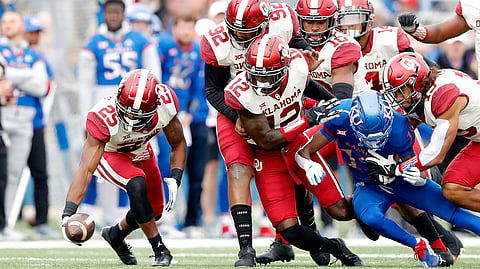

Many people think that college football is just the same as the NFL, but in reality, there is a large talent gap. Remember that NCAA is filled with colleges of all sizes and endowments, many of which are small and field underfunded programs. This means that the NCAAF Conference Division Winners might have a mixture of talented and mediocre players in their teams. This makes predicting the outcomes more difficult as the skill levels are often wildly different.
In college football, like in all sports, moneyline bets are the simplest and most likely to give you great results.
The bet has two sides, and each of these sides has a number attached to it. The number will either be positive or negative. A positive number tells you how much you will earn after placing a $100 bet. A negative number means you need to bet that amount, and if you win, you receive $100.
You can pay less or more than these figures, as they are simply there to show you the ratio.
A positive number indicates that the team is the underdog, meaning they are less likely to win. Negative numbers show you that the team is the favorite and is more likely to win.
The most popular bet in college football is the spread, in which the favorite team gives points and the underdog team receives points – sort of like strokes with a golf handicap.
The idea behind the spread is to create an even playing field. Because college teams will have varying abilities, this type of bet allows each team to be seen as equals.
For the favorites to win in a spread bet, they need to win the game, but also they have to win by more points than they are giving the underdog.
For the underdogs to win, they don’t have to actually win the game; they merely need to have more points than the favorite when adding the number of points they received in the wager to their actual total.i
For example, this is the betting wager you see:
Georgia Bulldogs -3.5 (-110) vs. Oklahoma Sooners +3.5 (-110)
The numbers we are focusing on are the +3.5 and -3.5.
Let’s say the game ended with the top-ranked Bulldogs beating the Sooners 17-15.
The Sooners didn’t win the game, but if you bet on the spread, you can add 3.5 to their 15 score for 18.5. 18.5 is higher than 17, and so the Bulldogs lost the game, but if you bet on the Sooners, you covered the spread and won the bet.
In the same scenario, if you bet on the Bulldogs, you would have to minus 3.5 to get your final results. 17 - 3.5 = 13.5, which is less than the Sooner’s 15, which means that although the Bulldogs won the game, you lost the bet.
These types of bets are great for bettors who don’t have a connection to a team, and aren’t sure how the game will go. Instead of betting on who will win, you bet on the total amount of points from both sides.
Let’s go back to the example we had before:
Georgia Bulldogs vs. Oklahoma Sooners Over 59.5 (-110), Under 59.5 (+110)
If you bet the Over and the score of the game totals 60 points or more, you win (even if one team wins 60-0 or the final is 31-29. Any total of 60 or more points is a winner. To win the Under bet, the total number of points scored has to be 59 points or less. So if you think the game is going to be an up-and-down scoring affair, you might bet the Over and if the weather is bad or the team's play dominating defense, you may bet the Under. Just keep in mind that the bookmakers understand this principle better than you do, and will adjust the Over/Under points accordingly.